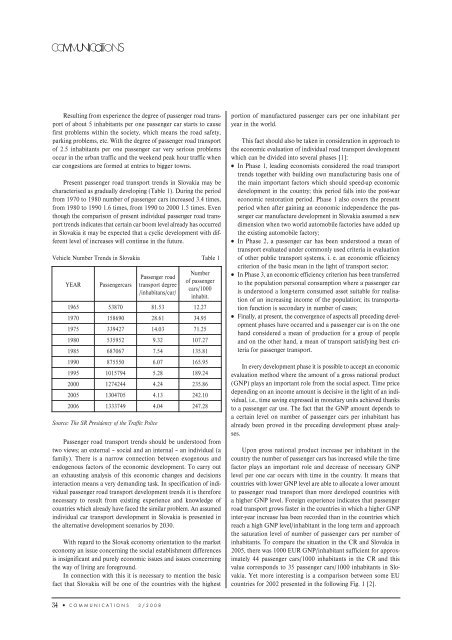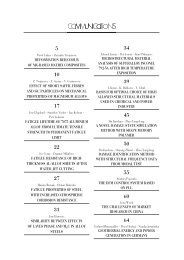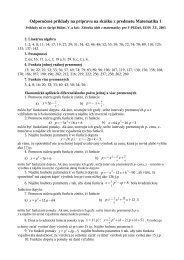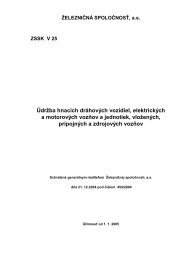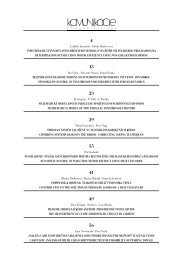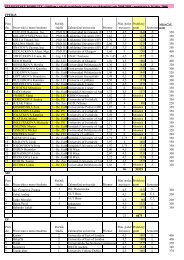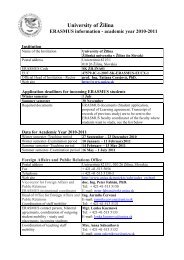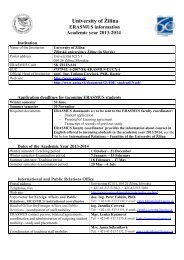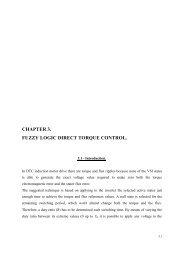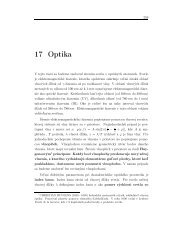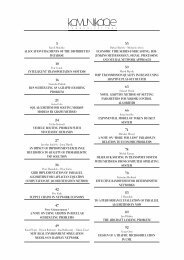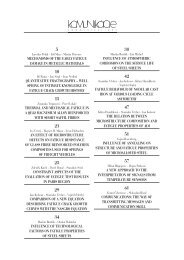simulation of torsion moment at the wheel set of the railway vehicle ...
simulation of torsion moment at the wheel set of the railway vehicle ...
simulation of torsion moment at the wheel set of the railway vehicle ...
You also want an ePaper? Increase the reach of your titles
YUMPU automatically turns print PDFs into web optimized ePapers that Google loves.
Resulting from experience <strong>the</strong> degree <strong>of</strong> passenger road transport<strong>of</strong> about 5 inhabitants per one passenger car starts to causefirst problems within <strong>the</strong> society, which means <strong>the</strong> road safety,parking problems, etc. With <strong>the</strong> degree <strong>of</strong> passenger road transport<strong>of</strong> 2.5 inhabitants per one passenger car very serious problemsoccur in <strong>the</strong> urban traffic and <strong>the</strong> weekend peak hour traffic whencar congestions are formed <strong>at</strong> entries to bigger towns.Present passenger road transport trends in Slovakia may becharacterised as gradually developing (Table 1). During <strong>the</strong> periodfrom 1970 to 1980 number <strong>of</strong> passenger cars increased 3.4 times,from 1980 to 1990 1.6 times, from 1990 to 2000 1.5 times. Eventhough <strong>the</strong> comparison <strong>of</strong> present individual passenger road transporttrends indic<strong>at</strong>es th<strong>at</strong> certain car boom level already has occurredin Slovakia it may be expected th<strong>at</strong> a cyclic development with differentlevel <strong>of</strong> increases will continue in <strong>the</strong> future.Vehicle Number Trends in Slovakia Table 1YEARPassengercarsSource: The SR Presidency <strong>of</strong> <strong>the</strong> Traffic PolicePassenger roadtransport degree/inhabitans/car/Number<strong>of</strong> passengercars/1000inhabit.1965 53870 81.53 12.271970 158690 28.61 34.951975 339427 14.03 71.251980 535952 9.32 107.271985 687067 7.54 135.811990 875550 6.07 165.951995 1015794 5.28 189.242000 1274244 4.24 235.862005 1304705 4.13 242.102006 1333749 4.04 247.28Passenger road transport trends should be understood fromtwo views; an external – social and an internal – an individual (afamily). There is a narrow connection between exogenous andendogenous factors <strong>of</strong> <strong>the</strong> economic development. To carry outan exhausting analysis <strong>of</strong> this economic changes and decisionsinteraction means a very demanding task. In specific<strong>at</strong>ion <strong>of</strong> individualpassenger road transport development trends it is <strong>the</strong>reforenecessary to result from existing experience and knowledge <strong>of</strong>countries which already have faced <strong>the</strong> similar problem. An assumedindividual car transport development in Slovakia is presented in<strong>the</strong> altern<strong>at</strong>ive development scenarios by 2030.With regard to <strong>the</strong> Slovak economy orient<strong>at</strong>ion to <strong>the</strong> marketeconomy an issue concerning <strong>the</strong> social establishment differencesis insignificant and purely economic issues and issues concerning<strong>the</strong> way <strong>of</strong> living are foreground.In connection with this it is necessary to mention <strong>the</strong> basicfact th<strong>at</strong> Slovakia will be one <strong>of</strong> <strong>the</strong> countries with <strong>the</strong> highestportion <strong>of</strong> manufactured passenger cars per one inhabitant peryear in <strong>the</strong> world.This fact should also be taken in consider<strong>at</strong>ion in approach to<strong>the</strong> economic evalu<strong>at</strong>ion <strong>of</strong> individual road transport developmentwhich can be divided into several phases [1]:● In Phase 1, leading economists considered <strong>the</strong> road transporttrends toge<strong>the</strong>r with building own manufacturing basis one <strong>of</strong><strong>the</strong> main important factors which should speed-up economicdevelopment in <strong>the</strong> country; this period falls into <strong>the</strong> post-wareconomic restor<strong>at</strong>ion period. Phase 1 also covers <strong>the</strong> presentperiod when after gaining an economic independence <strong>the</strong> passengercar manufacture development in Slovakia assumed a newdimension when two world automobile factories have added up<strong>the</strong> existing automobile factory;● In Phase 2, a passenger car has been understood a mean <strong>of</strong>transport evalu<strong>at</strong>ed under commonly used criteria in evalu<strong>at</strong>ion<strong>of</strong> o<strong>the</strong>r public transport systems, i. e. an economic efficiencycriterion <strong>of</strong> <strong>the</strong> basic mean in <strong>the</strong> light <strong>of</strong> transport sector;● In Phase 3, an economic efficiency criterion has been transferredto <strong>the</strong> popul<strong>at</strong>ion personal consumption where a passenger caris understood a long-term consumed as<strong>set</strong> suitable for realis<strong>at</strong>ion<strong>of</strong> an increasing income <strong>of</strong> <strong>the</strong> popul<strong>at</strong>ion; its transport<strong>at</strong>ionfunction is secondary in number <strong>of</strong> cases;● Finally, <strong>at</strong> present, <strong>the</strong> convergence <strong>of</strong> aspects all preceding developmentphases have occurred and a passenger car is on <strong>the</strong> onehand considered a mean <strong>of</strong> production for a group <strong>of</strong> peopleand on <strong>the</strong> o<strong>the</strong>r hand, a mean <strong>of</strong> transport s<strong>at</strong>isfying best criteriafor passenger transport.In every development phase it is possible to accept an economicevalu<strong>at</strong>ion method where <strong>the</strong> amount <strong>of</strong> a gross n<strong>at</strong>ional product(GNP) plays an important role from <strong>the</strong> social aspect. Time pricedepending on an income amount is decisive in <strong>the</strong> light <strong>of</strong> an individual,i.e., time saving expressed in monetary units achieved thanksto a passenger car use. The fact th<strong>at</strong> <strong>the</strong> GNP amount depends toa certain level on number <strong>of</strong> passenger cars per inhabitant hasalready been proved in <strong>the</strong> preceding development phase analyses.Upon gross n<strong>at</strong>ional product increase per inhabitant in <strong>the</strong>country <strong>the</strong> number <strong>of</strong> passenger cars has increased while <strong>the</strong> timefactor plays an important role and decrease <strong>of</strong> necessary GNPlevel per one car occurs with time in <strong>the</strong> country. It means th<strong>at</strong>countries with lower GNP level are able to alloc<strong>at</strong>e a lower amountto passenger road transport than more developed countries witha higher GNP level. Foreign experience indic<strong>at</strong>es th<strong>at</strong> passengerroad transport grows faster in <strong>the</strong> countries in which a higher GNPinter-year increase has been recorded than in <strong>the</strong> countries whichreach a high GNP level/inhabitant in <strong>the</strong> long term and approach<strong>the</strong> s<strong>at</strong>ur<strong>at</strong>ion level <strong>of</strong> number <strong>of</strong> passenger cars per number <strong>of</strong>inhabitants. To compare <strong>the</strong> situ<strong>at</strong>ion in <strong>the</strong> CR and Slovakia in2005, <strong>the</strong>re was 1000 EUR GNP/inhabitant sufficient for approxim<strong>at</strong>ely44 passenger cars/1000 inhabitants in <strong>the</strong> CR and thisvalue corresponds to 35 passenger cars/1000 inhabitants in Slovakia.Yet more interesting is a comparison between some EUcountries for 2002 presented in <strong>the</strong> following Fig. 1 [2].34 ● COMMUNICATIONS 3/2008


